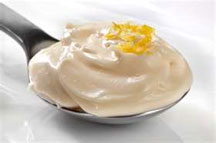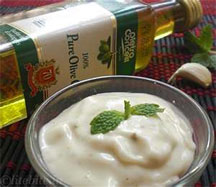Creamy Mayonnaise
By Patty Liston
 I love Mayonnaise. Not the "light" mayo, but the real creamy, rich, mayo that can be a secret ingredient to so many recipes. Who knew that an emulsion of oil, egg yolk, and vinegar or lemon juice could be so delicious?
I love Mayonnaise. Not the "light" mayo, but the real creamy, rich, mayo that can be a secret ingredient to so many recipes. Who knew that an emulsion of oil, egg yolk, and vinegar or lemon juice could be so delicious?
It is believed that the word "mayonnaise" was derived from the French word "moyeu", meaning yolk of egg. While this condiment was roaming around Europe as early as the 1700's, it wasn't until 1905 that it was first sold in Manhattan at Richard Hellman's delicatessen. By 1912 mayonnaise was being mass marketed using Mrs. Hellman's recipe and in the early 1920's Best Foods hit the market with their own version of mayo.
 For those watching their cholesterol intake, or vegans, or those allergic to egg yolks, there are now several egg free mayonnaise's that can be purchased at health food stores, and local markets.
For those watching their cholesterol intake, or vegans, or those allergic to egg yolks, there are now several egg free mayonnaise's that can be purchased at health food stores, and local markets.
Making Your Own Mayonnaise is fairly simple. I've done a little research and have combined several points so that making mayonnaise will be easy and fun for you!
Homemade Mayonnaise
Makes 1 Cup1 cup of light olive oil (less strongly flavored than standard olive oil) or other good-quality oil, like walnut or sweet almond oil
1 FRESH egg
Juice of 1 lemon, or vinegar (depending on your own taste - I like vinegar)
A pinch of salt (and pepper, if desired)
Water to thin the mayonnaise
Whisk or food processor

1. Separate the egg. Make sure it is a FRESH egg. Reserve the whites for other recipes.

2. Egg yolks contain a natural emulsifier, lecithin, which helps thicken sauces and bind ingredients.

3. Lemon juice or vinegar adds acidity and flavor to the mayonnaise.
For each cup of mayonnaise, add between 1 and 2 tablespoons of fresh lemon juice or vinegar, depending upon your tastes.

4. Combine the egg and acid in the bowl, whisking to mix.
You can make mayonnaise in a food processor or by hand, with a mixing bowl and whisk. The key for either method is to add oil very slowly, in a steady stream, while the processor is running or you're whisking vigorously. (I prefer a food processor as it allows for more control when adding the oil)

5. Continue to whisk constantly, adding the oil in a slow, steady stream.
If the mayonnaise starts looking too thick, add enough water to thin it to the consistency you desire. Add about a teaspoon of water at a time.
When the oil is all mixed in, the mayonnaise should be thick and fluffy, with your whisk forming ribbons through the mixture.
If it never thickened and you're stirring a puddle, chances are you will need to start over. (Or, if you're still partway through the process, you can save the emulsion by adding another egg yolk, whisking vigorously. Add in remaining oil, plus extra for a double recipe), and adjust the seasonings.

6. Use homemade mayonnaise on sandwiches, in dips, or in any recipes requiring mayonnaise. Dress it up with garlic for an aioli, or herbs and olives for a remoulade sauce.
Be sure to store fresh mayonnaise in the refrigerator and use within five days.
RECIPES
These recipes are not exact. Just experiment to make what would be the best for your taste!
- Fry Sauce: mix mayonnaise, and any red sauce such as ketchup, Tabasco, Buffalo Wing Sauce, smoky barbecue sauce; just depends on your taste. Some people use a dash of Worcestershire or soy sauce to balance out the sweetness of the red sauce.
- Ranch Dressing is made of buttermilk or sour cream, mayonnaise, and minced green onions, along with other seasonings.
- Rouille is aioli with added saffron, red pepper or paprika.
- Cajan Sauce: add Cajan spices to the mayo
- Sauce Remoulade, in classic French cuisine is mayonnaise to which has been added mustard, gherkins, capers, parsley, chervil, tarragon, and possibly anchovy essence.
- Tartar Sauce is mayonnaise spiced with pickled cucumbers and onion. Capers, olives, and crushed hardboiled eggs are sometimes included. A simpler recipe calls for only pickle relish to be added to the mayonnaise.
- Thousand Island dressing is a salmon-pink dressing that combines tomato sauce and/or tomato ketchup or ketchup-based chili sauce, minced sweet pickles or sweet pickle relish, assorted herbs and spices (usually including mustard), and sometimes including chopped hard-boiled egg - all thoroughly blended into a mayonnaise base.
- Certain variations of Honey Mustard are based on mayonnaise and are made by combining mayonnaise with plain mustard, brown sugar, and lemon juice.

Contribute to the Cook'n Club!
DVO would love to publish your article, prose, photography and art as well as your cooking, kitchen and nutrition tips, tricks and secrets. Visit the Newsletter Submission / Win Win for All section in our Forum for more information and details.

